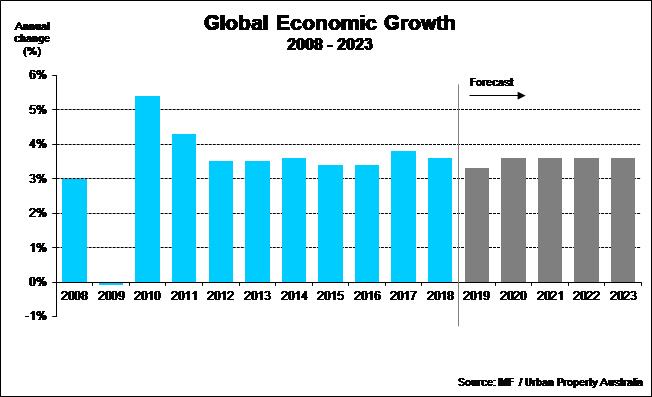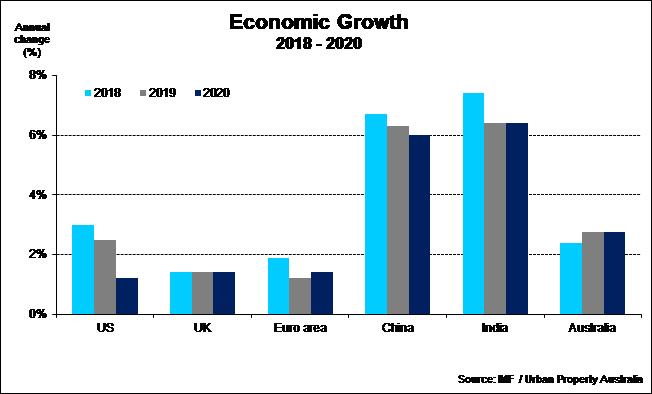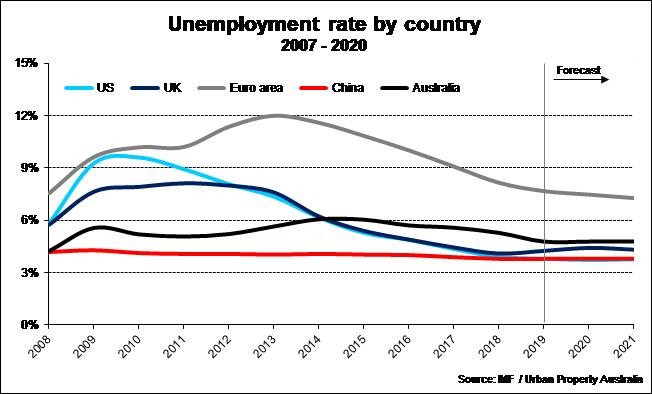Mid Year 2019 – Global Economy
August 5th 2019 | , Urban Property Australia
- Global growth continues to slow, impacted by the prospect of US sanctions and continued Brexit-related uncertainty
- Given the soft domestic conditions, the US Federal Reserve cut the US interest rates for the first time in 11 years
- Although GDP growth eased in China in the first part of 2019, there are some signs that momentum has picked up again
After modest improvement in the first quarter of 2019, indicators across the major advanced economies point to an easing in growth for the rest of 2019, driven largely by the US economy. With global growth slowing, global financial conditions have become more accommodative with a reduction in central bank policy rates across several economies. While the resumption of trade talks between the US and China is welcome, with the eventual outcome unclear, uncertainty around trade policy remains elevated and it is likely to weigh on business investment. Moreover, possible future US trade policy action is not limited to China and there are a range of other risks including the ongoing uncertainty about the United Kingdom’s exit from the European Union. Overall global growth is projected to remain subdued through the rest of 2019 and through 2020 as well, though the extent of that slowdown looks to be contained as central banks start to boost their assistance to growth, and as government budgets do the same.

United States
Having begun in June 2009, the U.S. is officially in its longest expansion, resulting in the GDP growing cumulatively by 25% and the unemployment rate dropping in the lowest since 1969. U.S. economic growth decelerated in the second quarter of 2019 at annual growth of 2.1% as tariffs and a global slowdown weighed on the U.S. economy. While the economy was boosted by more spending on infrastructure and defence, domestic demand continued to slow through the second half of 2019. Growth in consumer spending, which accounts for more than two-thirds of U.S. economic activity has now fallen to its weakest level in a year. Given the soft domestic conditions, the Federal Reserve cut the US interest rates for the first time in 11 years by 25 basis points with further cuts to be made through 2019. The U.S. economy is projected to grow by 2.1% in 2019 (down from 2.9% in 2018) and to ease further in 2020 with growth of 1.2% forecast.
China
China’s GDP for the second quarter grew at its slowest rate since the global financial crisis in 2008, 6.2%. In the near-term, economic growth in China is expected to be supported by targeted policy-easing measures but continue to moderate further out because of longer-term structural factors such as the declining working-age population. Although GDP growth eased in China in the March 2019 quarter, there are some signs that momentum has picked up again. In early March, the Chinese Government announced additional measures to increase spending on infrastructure to support growth in a manner that does not increase financial stability risks. The real challenge for China is how it will manage trade tensions with the United States with the outlook for trade policy still uncertain. While bilateral trade negotiations between the United States and China are continuing and there have been reports of progress in recent months, the US administration has recently threatened additional tariffs in the near term. Economic growth is projected to moderate to 6.3% this year, down from 6.7% in 2018 and is projected to grow by 6.0% in 2020.

Europe
The outlook for the Eurozone economy eased in the last few quarters, indicating that the region has likely passed the peak of the current recovery. The eurozone economy has been in an economic downturn since mid-2018, following the phase of the recovery that began in 2016. In line with this shift, the European Central Bank now expects a growth rate of 1.1% for 2019. Among the big eurozone economies, Spain continues to lead, having grown by 0.6% in the last quarter of 2018. Growth in France was lower, but still positive, while it stagnated in Germany and contracted in Italy. The impact of the UK leaving the European Union (EU) remains one of the biggest and incalculable external risks for the eurozone economy due to the strong and intensive economic relationships between the EU and its third-largest trading partner. However, the immediate threat of a hard Brexit has disappeared for the moment, with the EU agreeing to postpone the Brexit deadline to late October 2019.
United Kingdom
Economic growth has been volatile in recent quarters (and likely to remain volatile from quarter to quarter until the next Brexit deadline at the end of October 2019). Consumer spending growth has remained relatively strong, and government spending has picked up somewhat, but business investment has softened and contracted for four consecutive quarters in 2018 as anxiety about the uncertainties of Brexit become more acute. The jobs market has generally remained strong, with the employment rate at record levels and unemployment down to its lowest rate since the mid-1970s. Over the past year the scarcity of workers has finally fed through into increased real wage growth. Brexit-related uncertainty will continue to hold back business investment in the UK. According to the Bank of England, the UK economy is forecast to grow by 1.2% this year and 1.4% in 2020.
India
While China’s growth has eased to the lowest seen in 27 years, India’s economy has slowed to its lowest in five years at 5.8%. Despite softer growth, the Indian economy remains one of the fastest growing and possibly the least affected by global turmoil. The Indian economy is projected to once again gather momentum in the second half of 2019 as a result of the sustained rise in consumption and a gradual revival in investments, especially with a greater focus on infrastructure development. The improving macroeconomic fundamentals have further been supported by the implementation of reform measures, which has helped foster an environment to boost investments and ease banking sector concerns. Together, these augur well for a healthy growth path for the economy. India has already surpassed France to become the sixth-largest economy. By 2019, it may become the fifth-largest economy.

Copyright © 2019 by Urban Property Australia All rights reserved. No part of this publication may be reproduced in any form, by microfilm, xerography, electronically or otherwise, or incorporated into any information retrieval system, without the written permission of the copyright owner.



